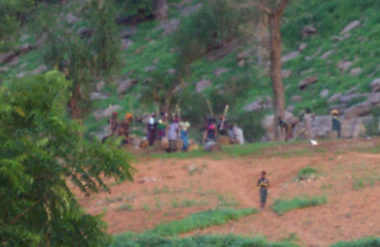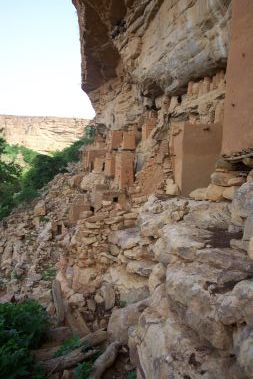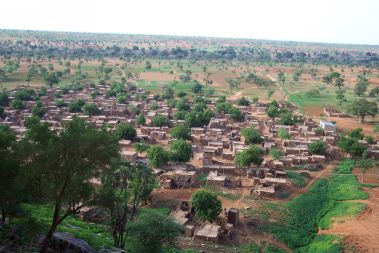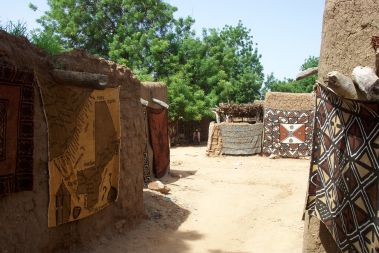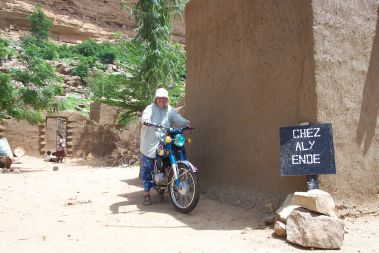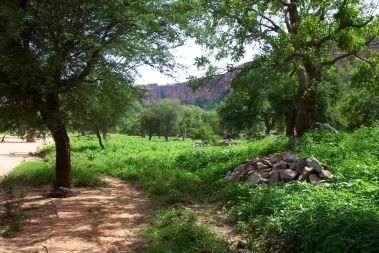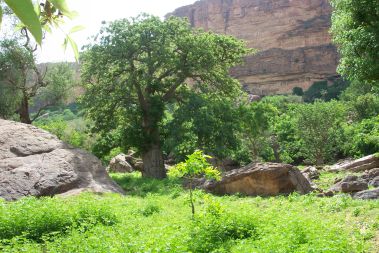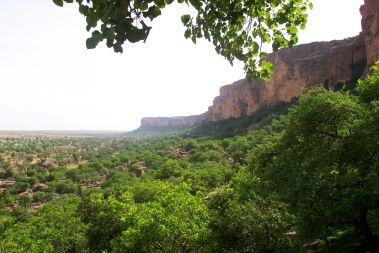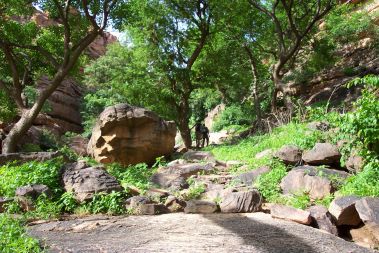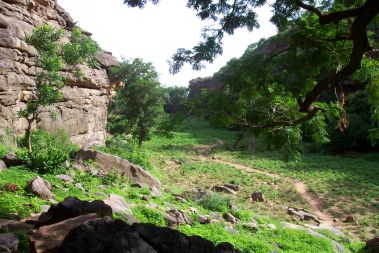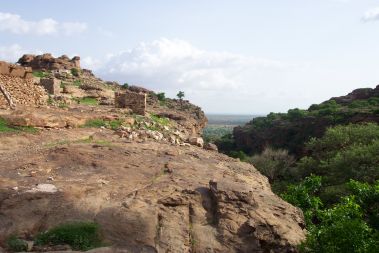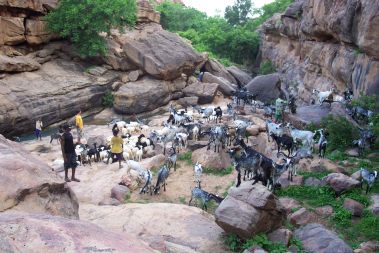Day 19 - Thursday, August 5th, 2004
It was very quiet last night though I was bothered a bit by mosquitoes though the coil did help out a bit. There was the distant sound of rhythmic thumping in the distance and climbing on the roof of one of the rooms I was able to see a group of about 10 ladies pounding millet under a tree actually a bit outside of the village. Behind them were the cliffs and the pygmy village. Quite magical really.
I had my normal bucket bath and then we had breakfast – typical continental again (bread with jam and tea/coffee). Our guide had brought the bed with him so it was getting a bit stale. Our new Japanese friend joined us at breakfast after having spent the night on the roof, “a bit wet” he said. Fantastic views of the cliff when he awoke I should imagine.
We convinced our guide that yes, we really did want to climb up to the pygmy village and he seemed to grudgingly comply. We made our way through to the edge of the village against the cliff where we clambered up the pile of stones leading to the village. It was quite an interesting experience. The village in the cliff is now only inhabited by the large birds constantly circling overhead (“raptors” I am told) and, during the day, children playing though, obviously, also by the occasional tourist who visits. The village was a bit tricky to get around in with old log-ladders leading from one roof to another and narrow paths winding their way between the rock and the buildings. The guide stopped with us for a few minutes at a spot where we could look across at the rest of the cliff-side dwellings as well as down on the village. Quite a view and very peaceful.
The pygmy houses are quite small – cylindrical mud mounds only a few feet tall and it makes me wonder whether they were used more for ceremonial purposes rather than living in as they do not seem terribly practical (the entrance tends to be on the side facing away from the cliff and near to the top of the mound).
Heading back down to the village we were once again hounded by children wanting to sell us their ornamental gourds. Arriving in the Campement we figured a safer thing to do would be to get the gourds brought to us so we could pick from them – which we did though it did cause a bit of confusion when they could not figure out whose gourds we had bought (they had to ask us to show them to us so they could figure it out).
We also had the chance to buy some Mali cloth that was brought in by an older gentleman and hung in various places around the camp. I was particularly attracted to one rather large cloth but when I attempted bargaining (my French evidently was not understandable so we had to go through an “interpreter”) he did not come down in price really at all so I gave up.
We eventually left the camp at about 8:30 on our way to the next village. As we left the village and walked along the narrow dirt path following the base of the cliff we noticed even more pygmy villages nestled up there in seemingly inaccessible places. The land at the base of the cliff is basically used for farmland with row after row of millet and corn. There were obvious signs of lots of rain with the path washed out and even flooded in places. We had to pass over many small rivers – our guide finding stepping stones or encouraging us to jump to avoid a soaking.
The baobab trees here are a bit of a different species than what we see in The Gambia with a series of concentric rings around the trunk at various heights. We did see some of the baobabs as we see them in The Gambia – a grey, smooth trunk.
We managed to get our guide to stop a few times as he set quite a blistering pace.
Eventually we arrived at the next village: Endé that is where they make indigo cloth – Hand woven cloth that is dyed with indigo. We were shown (briefly) how it is made (we were shown a bucket with indigo dye in it) and then we were swamped with ladies trying to sell us some cloth. Eventually I bought a cloth for 5,000 CFA that I thought was interesting with different patterns on it (basically areas on the cloth that have not been dyed as much).
Walking through the village was quite interesting as it was set up like a big shopping arcade with Mali cloth hanging from every wall with occasional courtyards set up as full-blown shops with ropes strung from one place to another and festooned with cloths of every conceivable colour and size. Unfortunately none of these really appealed to us as we continued through the village to stop at the Campement on the far side. There we sat down and had a bit of something to drink.
We had been there for about ten minutes when who decides to show up? Anne on the back of a motorbike! It turns out after getting her money yesterday today she arranged a tour of the Dogon area on the back of a motorcycle. Her hotel arranged it for her. Very nice. She indicated it was very exciting coming down on the road that we had walked along yesterday all the way into the valley (we left it half-way to go mountain climbing) and she had been able to visit the market in Kani-Kombolé that we had missed.
We soon parted company as we headed off once again. We passed by a few other villages but did not go to see them. We eventually came to another Campement outside of a village about 5 km from Endé where we stopped for lunch. We were not the only ones wanting something to eat as there were two groups already there when we first arrived and another arrived about half an hour later. We found a shady spot to rest and relaxed for a few minutes before being served lunch – macaroni and tomato sauce. Oh dear. We managed to filter some water before we headed out at about 12:30.
The next part of our trip was very tiring but ultimately very rewarding. We returned up to the plateau we had only left yesterday, climbing up a seeming pile of rocks on the face of the cliff. An obvious place to climb up with fantastic views afforded at every turn.
We all had a bit of difficulty with the climb but we eventually passed into a small level area about 3/4 of the way up the cliff – sort of a hidden Eden with level ground surrounded on either side by sheer rock faces with the land planted with something and a path winding it's way along the middle. The birds were singing, the trees were swaying the breeze – like I said, a hidden Eden. We met a man on a donkey heading down and w topped him to see if he would be riding the donkey down and he said “yes” (to our amazement, and also to our concern regarding the effort required by the animal in the process).
Eventually we climbed out of the small ravine and were surprised to find ourselves in a village perched on the top of the rocks: Begnimato. It was quite startling with the fact that there are no trees, just this village with all of its mud huts on top of the rock with a number of large rock formations jutting into the sky above. I say “village” but actually it is three villages, we learned, separated by religion/lifestyle: Catholic, Muslim and Animist. We stopped into the Campement in the Catholic section that was already being visited by a number of other tour groups. I guess this is a convenient place to stop for the guides – before and/or after the climb up from the valley below.
We also met up with Ebrima and Diana who are just starting their tour of the Dogon (and have not yet been down to the valley – good luck to them!). They had spent yesterday in the same way as Anne: Looking for money in Sevaré/Mopti.
Exhausted we were asked if we wanted to go swimming in a waterfall. Of course, this was not something I could pass up particularly since it was “not too far away”. My definition of “not to far” obviously differs from their definition since we had to leave our village, pass through the Muslim village then climb a good way down a ravine on the far side (a very tricky climb down) then along the base for a bit until we came to the spot. At the time I arrived it was being used by a number of tourists so I sat down to wait for them to finish before going in myself. It was basically a narrow, DEEP, pool at the bottom of a small waterfall (you could not see because it is along the pool at the far end where the walls get too narrow to get through) with the cliff face on one side and a level area of rocks on the other (where you can sit after bathing). There were also some local children having a bit of fun as well that was good to see.
Eventually the crowd thinned a bit so I decided to go in – I had my swimming suit on under my clothes and have had for the past few days on the chance that we would be able to do a bit of exactly this: Swimming in a waterfall. The water was indeed very deep as I was unable to see or feel the bottom (and tried not to really think about it as I don't like swimming in water where I can't see the bottom or do not know what is down there – childish really, I suppose). I rubbed our guides back (who was also enjoying a bit of a swim) then he rubbed mine showing me with disgust that my skin was coming off (sunburn). I headed back into the water and paddled around for a while then was greeted with a rather strange view: Over the rocks down-stream leading down to the valley floor a herd of goats appeared guided by their children guides. It was an invasion. I paddled in wonder watching as wave after wave of goats came to the area surrounding the pool.
Eventually I parted the goats, making my way back to my towel and clothes before heading back up to the plateau. Making it back up to the top I only went back down as I met Chris and Sue who had decided earlier not to go down (did I mention it was a scary climb down?) and had been sitting at the top just talking. After talking for a few minutes they thought it would be good to have a swim as well so I showed them the way down. It was a strange experience to be swimming with all the goats around us. Sue did not go in but Chris joined me for a few minutes.
Heading back to the camp we were greeted by the sight of even more people who were now laying claim to various rooms and roofs of the camp. Eventually we were shown our roof – the last of the ones in the camp complete with log ladder at a bit of an angle (causing a bit of a problem later when it was pitch dark and we tried to get up there). Our mattresses were put on the roof for us (just mattress on roof, literally) and I put our bags up there as Chris and Sue went for a short walk before dinner.
Dinner was decided by Sue and was beans (and rice) with sauce (and chicken). It was not too bad though I found it a bit bland. Earlier in the day we had been given a bit of what we call in The Gambia Niebé (beans with sauce) which we thought had been quite good so we asked for a bit of a different dish using the beans for dinner.
It is very crowded in the camp and sleep will be difficult as it is quite noisy. A lot of people are still up chatting and making a bit of noise. This is our last night in the Dogon. Tomorrow we head back to the real world.
⇒ Continue to Day 20 - Friday, August 6th, 2004
